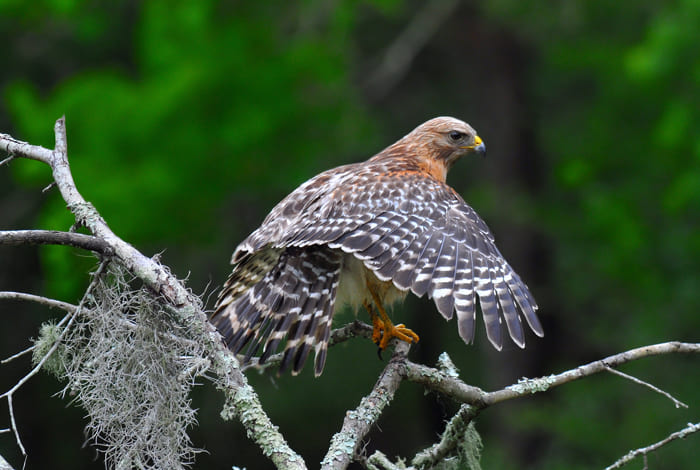Red-shouldered Hawks (Buteo lineatus) are magnificent birds of prey that inhabit the woodlands and swamps of North America.
They are named for the distinctive reddish-brown feathers on their shoulders, which contrast sharply with their plumage. They are also known for their piercing calls, which can be heard echoing through the woods.
With their striking appearance, impressive hunting skills, and adaptability, Red-shouldered Hawks are truly fascinating creatures that are worth learning more about.
On this page
Adult
Red-shouldered Hawks have five subspecies that are differentiated based on their location and physical appearance. Overall, adult birds have a dark brown upperside with pale spots, a dark brown head, a barred rusty-and-white underside, and blackish-and-white striped wings and tail.
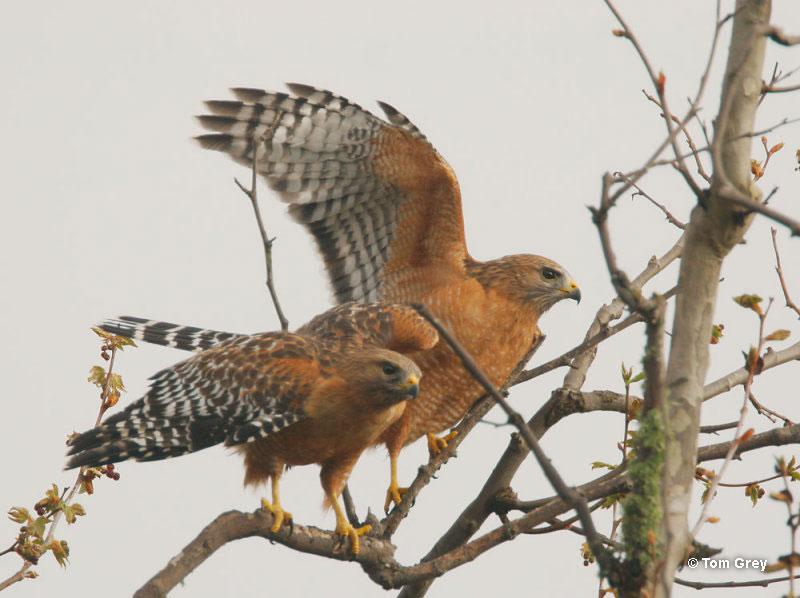
© Tom Grey
The characteristic red “shoulders” can be seen when the bird is perching. Birds in the western part of their range are usually redder, whereas birds in Florida are paler. In flight, look for pale white crescents near the wingtips.
They are medium-sized birds that can grow to be 17-24 inches long and weigh between 17-27 ounces. Female Red-shouldered Hawks are larger and heavier than males but otherwise, their appearance is the same.
Juvenile
Red-shouldered Hawks have only one brood per year with 2-5 dull white to faint bluish eggs with brown markings in a clutch. The incubation lasts for 32-40 days and is mostly done by the female. Younglings leave the nest about 5-7 weeks after hatching and will be taken care of for another 8-10 weeks.
Juvenile Red-shouldered Hawks look similar to adults but have much paler creamy undersides with brown streaks and spots. They’re browner overall, including their tails and wings. Similar to adults, they also have red shoulder patches and pale translucent crescents on their wings.
Red-shouldered Hawk Habitat
Red-shouldered Hawks inhabit mature deciduous or mixed bottomland woods, swamps, and wooded streamsides. They prefer places with tall trees and open understories.
In the western part of their range, you can find them in oak woodlands or riverside forests. The birds in Florida prefer mangroves and pine woods. In the east, they stick to mature deciduous and mixed forests.
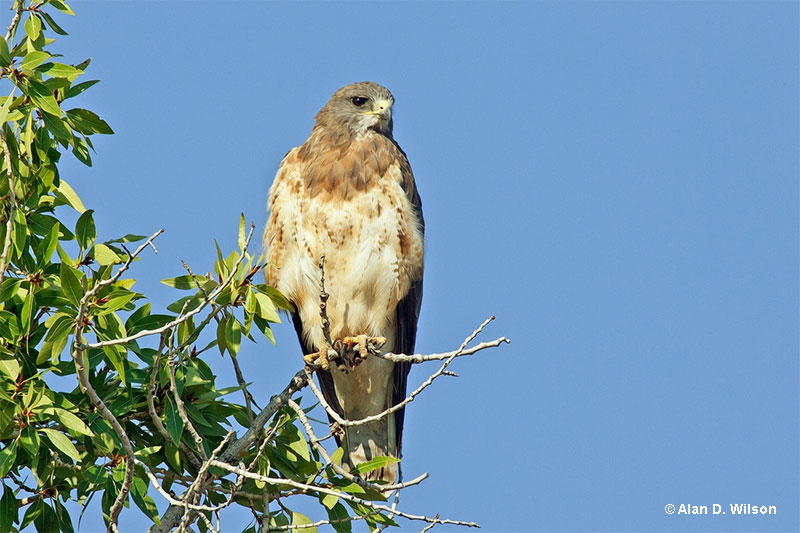
© Alan D. Wilson
These hawks prefer to nest in deciduous trees that are near a body of water. The pair builds their large 2 feet wide nest around the crotch of the main trunk. It is made of sticks and twigs and lined with softer plant material, such as moss or conifer sprigs, and looks like a platform.
Diet
Red-shouldered Hawks are birds of prey that feed on small animals. Their diet includes small mammals such as voles and chipmunks, birds such as sparrows and doves, amphibians such as toads, reptiles such as snakes, and even large insects. Sometimes they may also eat crayfish and snack on carrion.
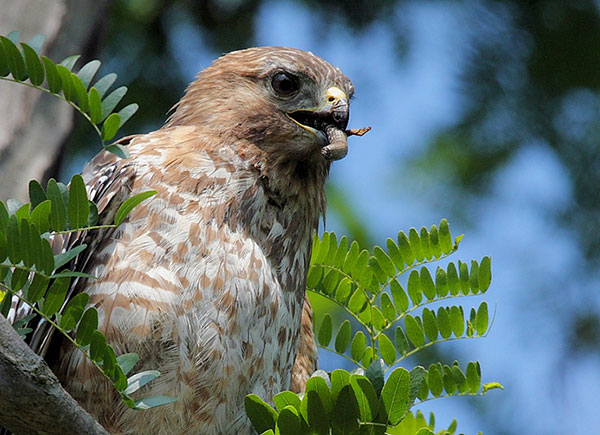
These birds hunt using two strategies. They mainly hunt by perching on a higher spot in the woods or in the open. When they’ve located their prey, they’ll swoop down and kill it by dropping on them.
Learn more: What do hawks eat?
You may also see it flying very low through the woodlands or high above open areas in search of prey. They sometimes cache food near their nest.
Behavior
Red-shouldered Hawks are solitary and territorial birds that never form flocks.
They are aggressive when it comes to defending their territories, attacking other birds of prey, and on occasion, even humans. However, in more human-populated areas, they may be a bit more approachable and indifferent.
The only time you see them with others of their kind is during the breeding season. During courtship, you may see them soaring and diving toward each other. The males ascend quickly, call and then dive toward the female. The male feeds his female during the incubation process and broods the eggs when she eats.
Range (and seasonal changes)
Red-shouldered Hawks range throughout the west coast of California and Baja California, parts of Mexico, and the eastern part of the United States with its range extending slightly into southern Canada.
The western population is mostly resident, whereas the birds from the Northeast and northern Midwest migrate southward to Mexico for the winter.
Red-shouldered Hawks are listed as species of least concern on the IUCN Red List. Their population is increasing. The biggest threat to their survival is the clearing and, therefore, destruction of their wooded habitats.
Wing shape
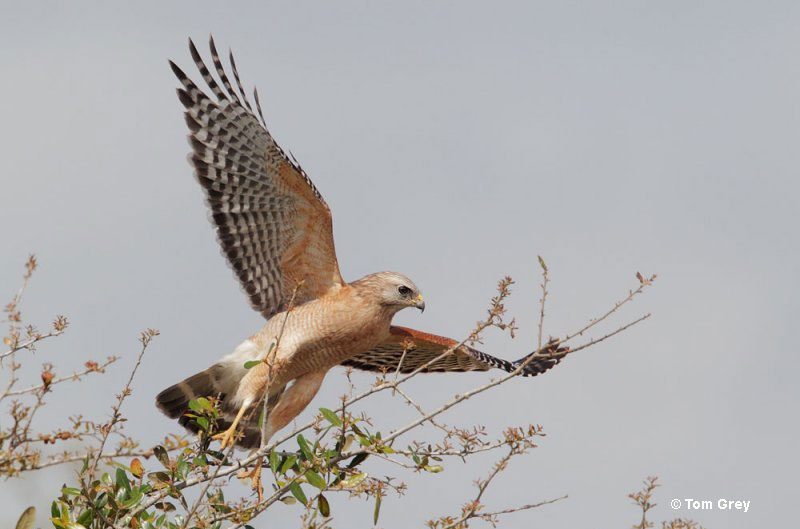
Red-shouldered Hawk’s wingspan measures 37-44 inches long, which is about twice the length of its body.
Their wings are long, broad, and rounded, which helps them soar effortlessly for extended periods of time and maneuver at low speeds. The slots between their primaries allow the birds to adjust their course while soaring.
Fun Facts
- Red-shouldered Hawks can be seen flying upside down for short distances. This is a part of their courtship ritual. They are also one of the noisiest hawks and some jays have learned to mimic their call and use it to their advantage.
- Nestling Red-shouldered Hawks like cleanliness. They aim over the edge of the nest and defecate so that the nest stays clean.
- The oldest known Red-shouldered Hawk lived to be 26 years old. The specimens that make it to adulthood live for 15-19 years on average.
- Red-shouldered Hawks are aggressive when it comes to defending their territory and often quarrel with other aerial predators. They’re often seen stealing food from and snatching nestlings from Great Horned Owls and crows.
- Red-shouldered Hawks return to the same nesting site year after year. The longest a pair has held the same territory was for 16 years.
Call
Red-shouldered Hawks have seven different calls to communicate, with the most common call being kee-aah which is often repeated many times in a row. This is given when the bird is alarmed or when it wants to advertise that a territory is occupied. Females call with a soft kee when they’re in the nest.
Similar Species
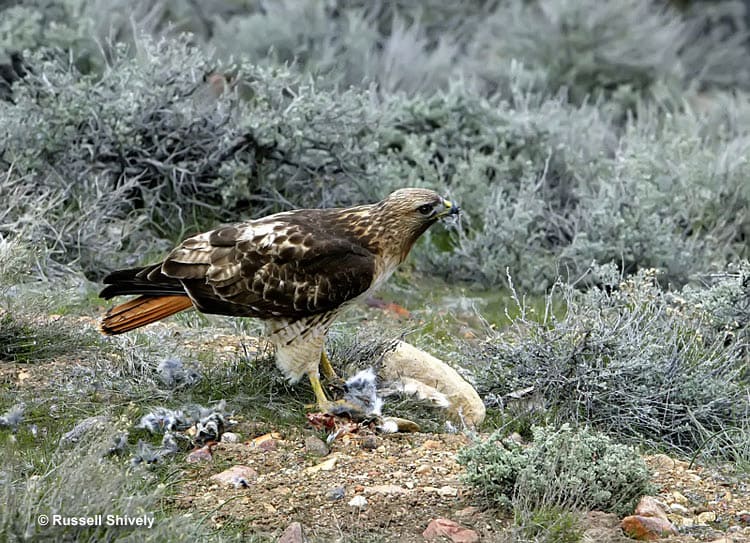
Red-tailed Hawk
Compared to Red-shouldered Hawks, Red-tailed Hawks have more white on their underside. Their backs and wings look pretty similar, but as the name hints, Red-tailed Hawks have red hues on their tails.
Learn more: Red-tailed Hawk vs Red-shouldered Hawk
Both are roughly the same size, but Red-tailed Hawks have greater wingspan.
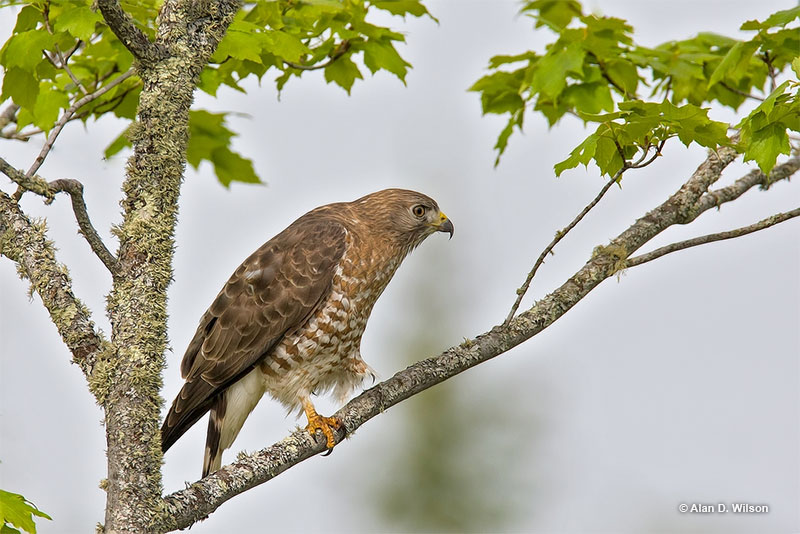
Broad-Winged Hawk © Alan D. Wilson
Red-shouldered Hawks and Broad-winged Hawks have similar barred patterns on their chests, but Broad-winged Hawks have a bit duller and darker plumage on their chests.
Broad-winged Hawks are a bit smaller in size.
They have some overlapping in their ranges.
Frequently Asked Questions
How rare is a Red-shouldered Hawk?
Red-shouldered Hawk is listed as of least concern on the IUCN Red List. They’re fairly common within their range, with their numbers slightly increasing.
What is the difference between a Red-shouldered Hawk and a Red-tailed Hawk?
Red-tailed Hawks are larger and more common than Red-shouldered Hawks. Red-shouldered Hawks have rust-colored breasts and black-and-white checkered wings and tails, whereas Red-tailed Hawks look pale creamy on the underside, have a dark belly band, and have a pale rust-colored tail.

